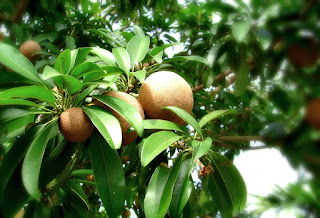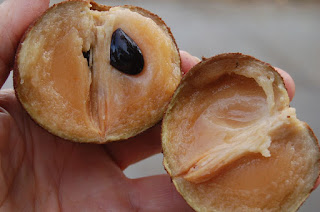 |
| Sapodilla (সফেদা) |
Common Names: Sapodilla, বাংলা (সফেদা) Chico, Chico sapote, Zapote chico, Zapotillo, Chicle, Sapodilla plum, Naseberry.
Far off Affinity: Star Apple (Chrysophyllum cainito), Abiu (Pouteria caimito), Canistel (P. campechiana), Lucmo (P. lucuma), Sapote (P. sapota), Green Sapote (P. viridis).
Birthplace: The sapodilla is accepted to be local to Yucatan and potentially other close-by parts of southern Mexico, and in addition northern Belize and northeastern Guatemala. It was presented long back all through tropical America and the West Indies and the southern part of the Florida terrain.
Adjustment: Sapodillas are not entirely tropical and adult trees can withstand temperatures of 26° to 28° F for a few hours. Youthful trees are more delicate and can be slaughtered by 30° F. The sapodilla appears to be similarly at home in moist and generally dry situations. In spite of the fact that it will develop in the milder parts of southern California, whether it will organic product consistently stays to be seen. A tree in La Mesa, Calif. has borne organic product. Cool California evenings appear to be a restricting variable. The moderate developing sapodilla makes an acceptable holder or nursery example.
Description:
Development Habit: The sapodilla is an appealing upright, moderate developing, seemingly perpetual evergreen tree. Unmistakably pyramidal when youthful, with age the tree might adds to a crown that is thick and adjusted or some of the time open and to some degree sporadic fit as a fiddle. It is solid and wind-safe and rich in a white, sticky latex. In the tropics it can develop to 100 feet, however joined cultivars are considerably shorter. A 40-year old tree in La Mesa, California is just around 12 feet tall.
Leaves: The leaves are very elaborate, 3 to 4-1/2 creeps long and 1 to 1-1/2 crawls wide. They are medium green, shiny, substitute and spirally grouped at the tip of forked twigs.
Blooms: Sapodilla blossoms are little, subtle and chime like, roughly 3/8 inch in distance across. They are borne on slim stalks in the axil of the takes off. There are a few flushes of blooms consistently.
Organic product: The natural product is round to egg-shape, 2 - 4 inches in distance across. The skin is chestnut and scruffy when ready. The tissue fluctuates from yellow to shades of cocoa and at times rosy chestnut, and might be smooth or of a granular surface. The flavor is sweet and charming, running from a pear flavor to crunchy chestnut sugar. Natural products can be seedless, however more often than not have from 3 to 12 hard, dark, sparkly, smoothed seeds around 3/4 crawl long in the focal point of the organic product.
Far off Affinity: Star Apple (Chrysophyllum cainito), Abiu (Pouteria caimito), Canistel (P. campechiana), Lucmo (P. lucuma), Sapote (P. sapota), Green Sapote (P. viridis).
Birthplace: The sapodilla is accepted to be local to Yucatan and potentially other close-by parts of southern Mexico, and in addition northern Belize and northeastern Guatemala. It was presented long back all through tropical America and the West Indies and the southern part of the Florida terrain.
Adjustment: Sapodillas are not entirely tropical and adult trees can withstand temperatures of 26° to 28° F for a few hours. Youthful trees are more delicate and can be slaughtered by 30° F. The sapodilla appears to be similarly at home in moist and generally dry situations. In spite of the fact that it will develop in the milder parts of southern California, whether it will organic product consistently stays to be seen. A tree in La Mesa, Calif. has borne organic product. Cool California evenings appear to be a restricting variable. The moderate developing sapodilla makes an acceptable holder or nursery example.
Description:
Development Habit: The sapodilla is an appealing upright, moderate developing, seemingly perpetual evergreen tree. Unmistakably pyramidal when youthful, with age the tree might adds to a crown that is thick and adjusted or some of the time open and to some degree sporadic fit as a fiddle. It is solid and wind-safe and rich in a white, sticky latex. In the tropics it can develop to 100 feet, however joined cultivars are considerably shorter. A 40-year old tree in La Mesa, California is just around 12 feet tall.
Leaves: The leaves are very elaborate, 3 to 4-1/2 creeps long and 1 to 1-1/2 crawls wide. They are medium green, shiny, substitute and spirally grouped at the tip of forked twigs.
Blooms: Sapodilla blossoms are little, subtle and chime like, roughly 3/8 inch in distance across. They are borne on slim stalks in the axil of the takes off. There are a few flushes of blooms consistently.
Organic product: The natural product is round to egg-shape, 2 - 4 inches in distance across. The skin is chestnut and scruffy when ready. The tissue fluctuates from yellow to shades of cocoa and at times rosy chestnut, and might be smooth or of a granular surface. The flavor is sweet and charming, running from a pear flavor to crunchy chestnut sugar. Natural products can be seedless, however more often than not have from 3 to 12 hard, dark, sparkly, smoothed seeds around 3/4 crawl long in the focal point of the organic product.
CULTURE:
Area: The sapodilla inclines toward a sunny, warm, ideally ice free area. They are exceptionally wind tolerant and can take salt shower.
Soil: Sapodillas are very much adjusted to numerous sorts of soil. It flourishes in extremely poor soils however thrives in profound, free, natural soil, and additionally light mud, sand or lateritic rock. Great seepage is key, the tree doing ineffectively in low, wet areas. It is exceedingly dry season safe and approaches the date palm in its resilience of soil saltiness.
Irrigation: The tree endures dry conditions astoundingly well. Most develop sapodilla trees get no watering, however watering system in dry season will expand profitability.
Preparation: Newly planted trees require little and continuous feedings to end up set up. Composts that contain 6-8% nitrogen, 2-4% accessible phosphoric corrosive and 6-8% potash give agreeable results. In the first place year applications ought to be made each a few months starting with 1/4 pound and step by step expanding to one pound. From that point, a few applications for every year are adequate, in sums proportionate to the expanding size of the tree.
Pruning: Sapodillas require next to no pruning.
Ice Protection: Although developed sapodilla trees will take a few degrees of ice, it is reasonable to give them overhead assurance if conceivable and plant them on the south side of a divider or building. Plants can likewise be secured with sheeting and such when huge ice is likely.
Proliferation: The sapodilla is most normally engendered by seed, which stay practical for a long time if kept dry. Effectively sprouted, they take five to eight years to manage. Since seed may not work out, vegetative engendering is alluring. Lacquer joining with seedlings as rootstock is the best system . Air layering and establishing of cuttings have not been effective.
Nuisances and Diseases: all in all the sapodilla tree remains entirely sound with practically no consideration. Creepy crawlies and infections more often than not don't bring about adequate harm to require control measures, in spite of the fact that the Wooly White Fly can at times be an issue. Oil showers in winter are proposed.
Harvest: It is frequently hard to advise when a sapodilla is prepared to pick. On the off chance that the skin is cocoa and the organic product isolates from the stem effectively without spilling of the latex, it is completely develop yet should be kept at room temperature for couple of days to mollify. It is best to wash off the sandy scruff before setting the organic product aside to mature. It ought to be eaten when firm-delicate, not soft. Firm-ready sapodillas might be kept for a few days in great condition in the home icebox. At 35° F they can be kept for 6 weeks. Completely ready natural products solidified at 32° F keep consummately for a month. The natural product is for the most part devoured new.
Miscellaneous: Chicle, the latex acquired from the bark of the tree has been utilized as a biting gum base for a long time.
Area: The sapodilla inclines toward a sunny, warm, ideally ice free area. They are exceptionally wind tolerant and can take salt shower.
Soil: Sapodillas are very much adjusted to numerous sorts of soil. It flourishes in extremely poor soils however thrives in profound, free, natural soil, and additionally light mud, sand or lateritic rock. Great seepage is key, the tree doing ineffectively in low, wet areas. It is exceedingly dry season safe and approaches the date palm in its resilience of soil saltiness.
Irrigation: The tree endures dry conditions astoundingly well. Most develop sapodilla trees get no watering, however watering system in dry season will expand profitability.
Preparation: Newly planted trees require little and continuous feedings to end up set up. Composts that contain 6-8% nitrogen, 2-4% accessible phosphoric corrosive and 6-8% potash give agreeable results. In the first place year applications ought to be made each a few months starting with 1/4 pound and step by step expanding to one pound. From that point, a few applications for every year are adequate, in sums proportionate to the expanding size of the tree.
Pruning: Sapodillas require next to no pruning.
Ice Protection: Although developed sapodilla trees will take a few degrees of ice, it is reasonable to give them overhead assurance if conceivable and plant them on the south side of a divider or building. Plants can likewise be secured with sheeting and such when huge ice is likely.
Proliferation: The sapodilla is most normally engendered by seed, which stay practical for a long time if kept dry. Effectively sprouted, they take five to eight years to manage. Since seed may not work out, vegetative engendering is alluring. Lacquer joining with seedlings as rootstock is the best system . Air layering and establishing of cuttings have not been effective.
Nuisances and Diseases: all in all the sapodilla tree remains entirely sound with practically no consideration. Creepy crawlies and infections more often than not don't bring about adequate harm to require control measures, in spite of the fact that the Wooly White Fly can at times be an issue. Oil showers in winter are proposed.
Harvest: It is frequently hard to advise when a sapodilla is prepared to pick. On the off chance that the skin is cocoa and the organic product isolates from the stem effectively without spilling of the latex, it is completely develop yet should be kept at room temperature for couple of days to mollify. It is best to wash off the sandy scruff before setting the organic product aside to mature. It ought to be eaten when firm-delicate, not soft. Firm-ready sapodillas might be kept for a few days in great condition in the home icebox. At 35° F they can be kept for 6 weeks. Completely ready natural products solidified at 32° F keep consummately for a month. The natural product is for the most part devoured new.
Miscellaneous: Chicle, the latex acquired from the bark of the tree has been utilized as a biting gum base for a long time.
For my other blogs: VISIT HERE


If you bite my pis or kiss my neck, I promise to rip your fucking clothes off. Hey, i am looking for an online sexual partner ;) Click on my boobs if you are interested (. )( .)
ReplyDelete